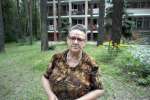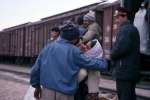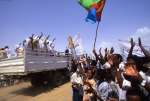- Text size
 |
|  |
|  |
| 
- Français
Study proposes ways to ease integration in Belarus, Moldova, Ukraine
News Stories, 10 April 2008

KYIV, Ukraine, April 10 (UNHCR) – A recent study aimed at helping three eastern European countries draw up integration plans for refugees has found that more needs to be done by officials and the refugees to make the process work.
"The success of integration does not depend on financial resources only; it also depends on the behaviour and thinking of officials, on understanding the concept of equality. And integration demands a capacity to adapt from refugees themselves," said the report, which was published in mid-March.
The authors of the European Commission-funded survey, UNHCR legal adviser Oldrich Andrysek and Tarja Rantala from Finland's Interior Ministry, interviewed some 300 people, including refugees, aid workers and government officials in Belarus, Moldova and Ukraine between April and November last year.
The three were republics of the Soviet Union until its dismantlement in 1991. They have since joined the 1951 Refugee Convention and taken great strides in building up asylum systems. Almost 6,500 people have been given refugee status since 1995 in the three countries, including some 5,360 in the Ukraine.
But the issue of integration had been largely neglected and that is why the three governments sought UNHCR's help in conducting the survey and preparing the report, entitled: "The Local Integration of Refugees in the Republic of Belarus, the Republic of Moldova and Ukraine. A Strategy for Action."
The study, which will help Belarus, Moldova and Ukraine draw up national action plans, covers all aspects of refugees' lives, including documentation, registration, access to education, employment, housing, social benefits and pensions, public health care, legal aid and naturalization.
Integration is the most viable option in the three countries, which lie on the eastern frontier of the European Union, and UNHCR will help them prepare a request for funding from the European Commission for integration projects forecast to be implemented from 2009-2012.
The study highlighted obstacles that must be addressed. For starters, it found that while refugees felt safer, they did not all feel welcome and at ease. Like the Afghan refugee woman in Ukraine, who said to interviewers: "Thank God there is no war here; but what will happen to us next?"
The report found that refugees had the capacity to help themselves, but said they needed a minimum of favourable conditions. These included access to employment, housing, education, health and social services. Special attention should be given to vulnerable persons and those with special needs.
Many battle for survival in countries which are already struggling on the economic front. "How can I find a job in Moldova if Moldovans cannot find jobs themselves," said a Syrian refugee living in Chisinau, Moldova's capital.
Indeed, employment was the biggest problem facing refugees in the three countries, along with housing. The report said wages tended to be lower and rents higher than for locals. "It is difficult to rent an apartment for a family with many children, because people are afraid when they see so many children," said an Afghan refugee living in Belarus.
Language is another stumbling block to integration. In Belarus, Moldova and Ukraine many refugees have a good command of Russian but cannot speak official languages such as Ukrainian and Romanian (in Moldova). UNHCR funds small-scale language courses, but the study said more needed to be done and it proposed several concrete measures to this end.
The study also said that some officials were holding up the integration process. Attitudes towards refugees varied from country to country, it said, while noting that some officials opposed the presence of refugees in their region.
There have also been several incidents of xenophobia in Ukraine. The survey authors recommended that the three governments actively implement anti-discrimination and anti-racism policies and pursue awareness-raising activities.
The survey also noted some success stories that should serve as an inspiration for those tasked with drawing up the national action plans for integration. In Kyiv, for example, an Angolan refugee working as an assistant manager at two hotels had helped find employment for dozens of African refugees.
In Gomel, the second largest city in Belarus, Afghan refugees who set up a billiard club with UNHCR help two years ago were not only pulling in a healthy profit but also hiring other refugees and paying taxes to the state. This was the most effective way of paying back the state and thanking it for giving them the opportunity to rebuild their lives.
The study was conducted within the framework of the Soderkoping process, which was launched in 2001 to address cross-border cooperation issues arising with the EU enlargement eastwards and to promote dialogue on asylum and irregular migration among the countries situated along the EU eastern border – Belarus, Estonia, Hungary, Latvia, Lithuania, Moldova, Poland, Romania, Slovakia and Ukraine.
By Natalia Prokopchuk in Kyiv, Ukraine







































